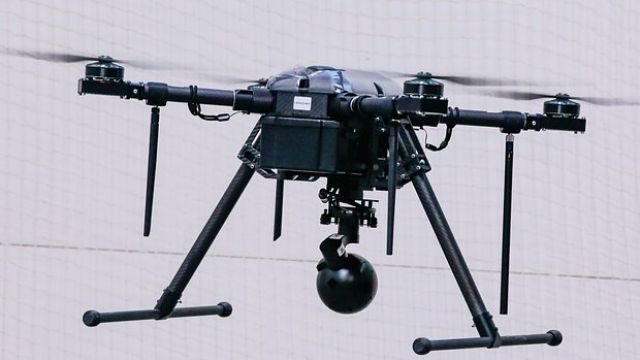A recent post on X by Clash Report claims Russia has developed a 50-kilometer fiber-optic cable for first-person view [FPV] drones, a potential leap in drone warfare technology. If confirmed, this would mark the longest fiber-optic cable used in the Ukraine conflict, surpassing the previously reported maximum range of 41 kilometers. The claim, however, awaits independent verification.

This development underscores the escalating technological race in unmanned systems, where fiber-optic cables offer a critical edge by enabling drones to operate beyond the reach of electronic jamming, potentially reshaping how far and how effectively these weapons can strike on the modern battlefield.
The significance of this reported advancement lies in its ability to push the boundaries of drone operations. FPV drones, small and agile quadcopters piloted in real time through a video feed, have become a cornerstone of modern warfare, particularly in the Ukraine conflict.
Unlike traditional drones that rely on radio signals, which can be disrupted by electronic warfare systems, fiber-optic FPV drones use a thin, lightweight cable to maintain a direct, high-bandwidth connection to their operators. This cable, often less than 0.1 millimeters thick, unspools from a reel mounted on the drone as it flies, ensuring a stable, high-quality video feed and control link immune to jamming.
The technology allows operators to guide the drone with precision, even in environments saturated with electronic countermeasures, achieving hit rates as high as 95% compared to roughly 20% for radio-controlled drones, according to battlefield reports.
Yet, the system has limitations: the cable’s length caps the drone’s range, and the delicate fiber can tangle in complex terrain or snap if mishandled, while the reel adds weight that can reduce payload or flight time.
The reliance on fiber-optic cables stems from the growing sophistication of electronic warfare. Both Russian and Ukrainian forces have deployed advanced radio-electronic combat systems, or REB, designed to jam radio signals and disrupt drone operations.
These systems, which can render radio-controlled drones ineffective by severing their connection to the operator, have driven the adoption of fiber-optic alternatives. The cables provide a secure, interference-proof link, allowing drones to strike high-value targets like armored vehicles or artillery with pinpoint accuracy, even in contested areas.
The reported 50-kilometer cable, if real, would significantly extend this capability, enabling drones to reach deep into enemy territory—potentially targeting logistics hubs or command posts that were previously out of reach.
Such a range would dwarf earlier systems, which typically operated at 10 to 20 kilometers, with Ukraine’s 41-kilometer cable previously setting the benchmark, as noted in a January 2025 Defense Express report. However, the feasibility of a 50-kilometer cable raises questions about weight, durability, and the logistical challenges of deploying such a long, fragile tether in combat.
The evolution of FPV drones with fiber-optic cables has already left its mark on the battlefield. In August 2024, Russian forces in the Kursk region used fiber-optic FPV drones, likely the “Prince Vandal Novgorodsky” developed by the Uskhuynik center, to destroy an Australian-supplied Bushmaster Protected Mobility Vehicle.
The drone navigated through burning wreckage, its high-resolution video feed unaffected by Ukrainian jamming attempts, delivering a precise strike that disabled the vehicle’s chassis and engine, according to Russian military channels.
The Bushmaster, a 4×4 wheeled armored personnel carrier, weighs approximately 11 tons and is designed to carry up to nine soldiers, offering protection against small arms fire and improvised explosive devices. Its destruction highlighted the ability of fiber-optic drones to neutralize well-defended targets, exploiting their immunity to electronic countermeasures.
Similarly, in January 2025, near Pokrovsk, Russian drones reportedly struck a Ukrainian logistics convoy, damaging two armored vehicles and a 2S19 Msta-S self-propelled howitzer.
The Msta-S, a 152mm artillery system with a range of up to 29 kilometers, is a critical asset for delivering long-range fire support, and its loss underscores the growing threat of these drones to heavy military hardware.
Ukrainian forces have also leveraged fiber-optic FPV drones to devastating effect. In May 2025, near Soledar, a Ukrainian drone with a 20-kilometer cable struck another Russian 2S19 Msta-S, according to posts on X by the 53rd Mechanized Brigade’s Signum battalion.
The drone’s clear video feed allowed it to maneuver around defensive netting and deliver an explosive payload directly into the howitzer’s turret, rendering it inoperable. The Msta-S, with its 42-ton frame and ability to fire up to eight rounds per minute, is a mainstay of Russian artillery, and its destruction demonstrated the precision and resilience of fiber-optic systems.
Another notable operation occurred the same month in Tatarstan, where a Ukrainian drone attacked a factory producing Shahed kamikaze drones in Yelabuga. The strike, which damaged a production line, showcased the potential of fiber-optic drones to conduct long-range missions against strategic targets, bypassing Russian electronic defenses.
The Bushmaster and Msta-S are not isolated examples. Fiber-optic drones have targeted a range of military hardware, from tanks to artillery, transforming the battlefield. For comparison, the U.S. military’s Switchblade 300 loitering munition, a kamikaze drone with a 10-kilometer range, relies on radio signals and is vulnerable to jamming, limiting its effectiveness in contested environments.
Similarly, Israel’s Spike LR2 anti-tank missile, which uses a fiber-optic cable for guidance, has a range of 5.5 kilometers, significantly shorter than the reported Russian and Ukrainian systems. These comparisons highlight the unique advantage of extended-range fiber-optic drones, which combine low cost—often under $1,000 per unit—with the ability to strike high-value targets worth millions, such as the $4 million Msta-S or the $1.5 million Bushmaster.
Yet, the technology is not without flaws. The cables, while strong in tensile strength, can break if bent too sharply, and the added weight of the reel reduces the drone’s maneuverability, making it slower than radio-controlled counterparts, as noted by Ukrainian commander Robert “Magyar” Brovdi in a May 2025 interview with The War Zone.
The tactical impact of fiber-optic drones extends beyond individual strikes. Their ability to operate in jamming-heavy environments has forced both sides to rethink battlefield strategies. In Kursk, Russian drones disrupted Ukrainian supply lines by targeting vehicles on key routes, turning what soldiers called a “road of life” into a gauntlet of destruction, according to a May 2025 Washington Post report.
Ukrainian troops, unable to rely on electronic warfare, resorted to physical countermeasures like nets or small arms fire to down the drones, but these methods are inconsistent and expose soldiers to danger. Conversely, Ukrainian forces have used fiber-optic drones to clear Russian electronic warfare systems, creating openings for radio-controlled drones to strike, as explained by Captain Yuriy Fedorenko of Ukraine’s Achilles regiment in an April 2025 Guardian article.
This layered approach—using fiber-optic drones as a first wave to neutralize jamming—has amplified their strategic value, allowing follow-up attacks with cheaper, more agile drones.
Historically, wire-guided systems are not new. The U.S.-developed TOW missile, introduced in the 1970s, used a wire to guide its anti-tank warhead over distances of up to 3.75 kilometers, offering precision in environments where radio signals could be disrupted.
The Israeli Spike-ER missile, with its 10-kilometer fiber-optic cable, further refined this concept, enabling operators to adjust the missile’s path mid-flight. In Ukraine, however, the application of fiber-optic technology to low-cost FPV drones has democratized long-range precision strikes, making them accessible to smaller units and even individual operators.
Early experiments with fiber-optic drones date back to 2022, when Ukrainian developers tested prototypes like the “Banderyk-Strichka,” which had a modest 1-kilometer range, according to a January 2025 Espreso TV report.
By 2024, Russia had scaled up production, deploying drones like the Prince Vandal, which some analysts, such as Ukrainian expert Serhii “Flash,” suggest may be rebranded Chinese models sold at a markup.
The reported 50-kilometer cable, if verified, would represent a significant leap. Current systems, like Ukraine’s 30-kilometer fiber-optic kit unveiled in May 2025 by Defense Express, already push the limits of what small drones can carry.
A 50-kilometer cable, potentially weighing several kilograms, would require a larger drone or a lighter, more durable fiber, raising questions about practicality. The reel alone could compromise the drone’s speed and agility, and deploying such a long cable across varied terrain—forests, urban areas, or rivers—risks entanglement or breakage.
Russian military channels have not provided technical details, and the Clash Report post offers no specifics on the drone model or manufacturer, leaving room for skepticism. Independent analysts, like Samuel Bendett in a May 2025 X post, have noted that while fiber-optic drones are effective, their limitations make them a tactical tool rather than a game-changer.
The broader implications of this technology are undeniable. Fiber-optic drones have exposed vulnerabilities in traditional defenses, rendering expensive electronic warfare systems less effective. Armored vehicles, once shielded by jamming, are now at risk from drones costing a fraction of their value.
The Msta-S, for instance, requires a crew of seven and extensive logistical support, yet a single drone can disable it in seconds. This asymmetry has forced armies to adapt, dispersing units or hiding equipment in buildings, though fiber-optic drones can navigate enclosed spaces, as seen in a Russian strike on a Ukrainian Bohdana howitzer concealed in a barn, reported by Forbes in March 2025.
Countermeasures, such as Ukraine’s mobile radar systems or drone-on-drone attacks, are emerging but remain limited. A Ukrainian unit, the Magyar Birds Brigade, reported success in intercepting Russian fiber-optic drones using radar-guided FPV strikes, but scaling this approach across a 600-mile front is challenging, according to a January 2025 War Zone report.
Looking ahead, the proliferation of fiber-optic drones signals a shift in warfare. Their success is likely to spur investment in autonomous systems that combine fiber-optic reliability with artificial intelligence, reducing the need for human operators.
Both sides are already exploring such innovations, with Ukraine’s Azov Brigade testing drones that integrate fiber-optics with advanced sensors, as reported by The Kyiv Independent in May 2025. Meanwhile, the physical limitations of cables are driving research into hybrid systems that could switch between wired and wireless control.
These advancements, however, will demand new defenses, from acoustic sensors to laser-based systems, as traditional jamming becomes obsolete. The reported 50-kilometer cable, while unconfirmed, highlights the relentless pace of this technological race, where each side seeks to outmaneuver the other with ever-evolving tools.
From this observer’s perspective, the emergence of fiber-optic FPV drones reflects a broader trend: the democratization of precision warfare. What began as a niche technology has become a battlefield staple, capable of leveling multimillion-dollar assets with a $400 drone.
The reported 50-kilometer cable, if real, would push this capability further, challenging armies to rethink how they protect their forces and supply lines. Yet, the lack of concrete evidence raises doubts about its immediate impact. Can such a long cable withstand the chaos of combat, or is it a propaganda boast meant to unsettle adversaries?
***
Follow us everywhere and at any time. BulgarianMilitary.com has responsive design and you can open the page from any computer, mobile devices or web browsers. For more up-to-date news, follow our Google News, YouTube, Reddit, LinkedIn, and Twitter pages. Our standards: Manifesto & ethical principles.

